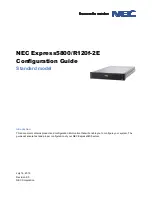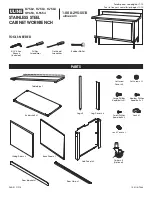
‘
Barracuda 36ES2 Installation Guide
ST336938LW, ST318438LW, ST336918N and ST318418N
SCSI interface disc drive
Publication Number:
100182976
, Rev. A, December 2001
Handling precautions/electrostatic discharge protection
• Disc drives are fragile. Do not drop or jar the drive and handle the drive
only by the edges or frame.
• Drive electronics are extremely sensitive to static electricity. Keep the
drive in its antistatic container until you are ready to install it. Wear a wrist
strap and cable connected to ground. Discharge static from all items near
or that will contact the drive. Never use an ohmmeter on any circuit
boards.
• Turn off the power to the host system during installation.
• Always use forced-air ventilation when operating the drive.
• Use caution when troubleshooting a unit that has voltages present.
• Do not disassemble the drive; doing so voids the warranty.
• Return the entire drive for depot service if any part is defective.
• Do not apply pressure or attach labels to circuit board or drive top.
Electromagnetic compliance
See Safety and Regulatory Agency Specifications, p/n 75789512.
Drive characteristics
ST336938LW/
ST318438LW/
ST336918N
ST318418N
Formatted capacity
36.954 Gbytes
19.924 Gbytes
Total # of data blocks
72,176,565
36,088,282
(044D53B5h)
(0251C800h)
Cylinders (user accessible)
56,332
56,332
Heads (user accessible)
2
2
Disc ro/–5%
7,200 RPM
7,200 RPM
Operating voltages
+5V
+12V
+5V
+12V
Typical operating
current (amps)
1.11
0.72
1.11
0.72
What you need
• Phillips screwdriver and four 6-32 UNC drive mounting screws
• Forced-air ventilation to provide adequate drive cooling
• An unused drive power connector
To operate at LVD transfer rates, you may also need an LVD-capable SCSI
host adapter, LVD I/O cable and active negation external terminator.
Multimode interface
This drive can operate in single-ended (SE) or low voltage differential (LVD)
mode. This multimode capability provides backwards compatibility so you
can use it with or without an LVD-capable host adapter. The primary bene-
fits of LVD technology include faster transfer rates, reduced power con-
sumption, increased allowable cable lengths, and improved device
connectivity.
You can configure the drive to switch between SE and LVD modes automat-
ically or force it to operate in SE mode only. To configure this option, see
Figure 2.
Note. To operate in LVD mode, all devices on the same bus (cable) must
be running in LVD mode. If you add any SE device to the bus, all
devices on that bus operate in SE mode.
Note. Some LVD host adapters provide an LVD connector and an SE con-
nector on the same host adapter to allow you to run SE and LVD
drives concurrently at their maximum capabilities. Check your SCSI
host adapter documentation. See Figure 4.
Note. Do not mix LVD drives on the same bus (cable) with high voltage dif-
ferential (HVD) devices—drive damage may occur.
N model drives are not multimode devices. They are single-ended (SE)
devices and cannot be configured to operate in LVD mode.
Installation instructions
1.
Set the SCSI ID
Determine which SCSI IDs are already being used in the system and then
assign this disc drive a SCSI ID that isn’t already being used. Use the J6
connector located on the front of the drive to set the SCSI ID (see Figure 1).
• Most Barracuda® 36ES2 drives are factory set with the SCSI ID set at 0.
If this is the only SCSI drive in your system and there are no other SCSI
devices on the bus (cable), you can leave this drive’s SCSI ID set to 0 and
proceed to the next step.
• The host system’s SCSI controller usually uses SCSI ID 7.
• If you have an LW model drive, the ID may be set using either J6 or J5
(located on the rear of the drive).
• Some systems provide a cable designed to connect to the J5 jumper
block on the drive to remotely set the ID. You can connect this cable to J5
and use the host-provided remote switch to set the SCSI ID.
Figure 1.
Setting the SCSI ID
2.
Configure termination
If you are installing the drive in a system that has other SCSI devices
installed, terminate only the end devices on the SCSI bus (cable).
N models have non-removable internal terminators that you can enable
using J2 pins 15 and 16. These terminators are enabled in the default con-
figuration. To disable these internal terminators, simply remove the jumper
from J2 pins 15 and 16. See Figure 3.
LW models do not have internal terminators or any other way of adding
internal termination on the drive. You must provide external termination
when termination is required. This is normally done by adding an inline ter-
minator on the end of the cable. See Figure 4 for an illustration showing a
system configuration that uses an external terminator.
• Use active (ANSI SCSI-2 Alternative 2) single-ended terminators when
terminating a bus operating in single-ended mode.
• Use SPI-2-compliant active low voltage differential terminators when ter-
minating a SCSI Ultra2 bus operating in LVD mode.
• The host adapter is normally on the other end of the bus and internally
terminated. You can configure your bus with another device on the other
end if you remove termination from the host adapter.
3.
Configure terminator power
Terminators have to get power from some source. The default configuration
results in the drive not supplying termination power to the bus. You should
normally leave this drive set at this default unless your host system requires
the drive to supply termination power to the bus. To configure this drive to
supply termination power to the bus, place a jumper on J2 pins 1 and 2 as
shown in Figure 2.
SCSI ID = 0
(default)
Jumper Plug
(enlarged to
show detail)
J6
Drive
Front
Pin 1
Reserved
A
2
A
1
A
0
A
L
E
D
R
E
S
3
SCSI ID = 1
SCSI ID = 2
SCSI ID = 3
SCSI ID = 4
SCSI ID = 5
SCSI ID = 6
SCSI ID = 7
SCSI ID = 8
SCSI ID = 9
SCSI ID = 10
SCSI ID = 11
SCSI ID = 12
SCSI ID = 13
SCSI ID = 14
SCSI ID = 15
J1
DC Power
J1
68 Pin
SCSI I/O
Connector
Drive HDA
Rear
SCSI ID = 8
SCSI ID = 9
SCSI ID = 10
SCSI ID = 11
SCSI ID = 12
SCSI ID = 13
SCSI ID = 14
SCSI ID = 15
A
not used
3 A2 A1
SCSI ID = 0
SCSI ID = 1
SCSI ID = 2
SCSI ID = 3
SCSI ID = 4
SCSI ID = 5
SCSI ID = 6
SCSI ID = 7
A0
J5
Pin 1
4P
3P 2P
1P
PCBA
Pin 1
+5V
Ground
(default)
(LW drives only)




















